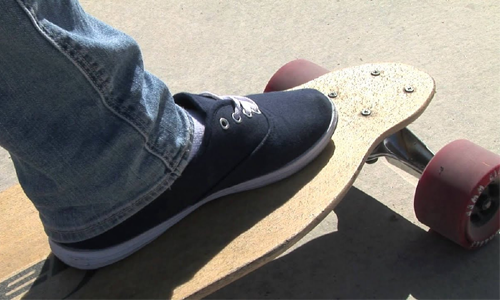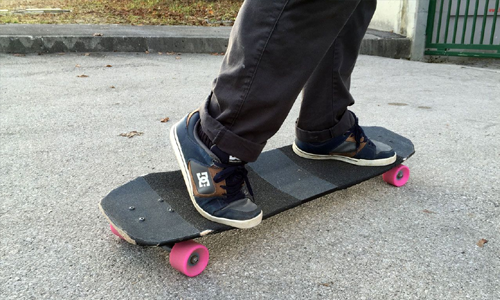Foot placement on a longboard affects your balance and control when turning, stopping, and carving. Improper foot placement can lead to falls and injury – so you must get this right from the beginning.
To know foot placement on a longboard, you should check for any other signs of damage, such as worn-out trucks, wheels, or bearings, so those can be fixed or replaced immediately. Above all, ensure your longboard is safe to ride before taking off again.
If you have any doubts, seek professional help. These precautionary steps can ensure you have a safe and enjoyable time while riding your longboard.
How to Place Foot on a Longboard (Correctly)
Mastering the correct foot placement on a longboard is crucial for maintaining balance, control, and overall enjoyment while riding.
So, let’s check how to correctly place your foot on a longboard.
Step 1: Determine Your Stance
The first step is to identify your natural stance. There are two common stances in longboarding: regular and goofy.

Regular stance refers to having your left foot as the front foot, while a goofy stance means your right foot is in the front.
To determine your stance, try standing on a flat surface and have someone gently push you from behind. The foot you instinctively step forward with is likely your front foot on the longboard.
Step 2: Place Your Front Foot
Once you know your stance, position your front foot across the board perpendicular to the direction you’ll be heading.
Your front foot should be placed just behind or slightly above the front trucks. Ensure that your toes are pointing forward or slightly angled to provide stability and control. Placing the ball of your foot near the front trucks allows for efficient steering and maneuverability.
Step 3: Position Your Back Foot
Now it’s time to position your back foot. Place it over or slightly in front of the rear trucks.
The toes of your back foot can be angled diagonally or aligned parallel to the edge of the board, depending on your comfort level. This placement offers stability and control during turns, slides, and maneuvers.
Step 4: Maintain Proper Weight Distribution
To maintain balance and control, distribute your weight evenly between both feet. Avoid putting excessive pressure on either foot, as it can affect stability and hinder your ability to respond to changes in terrain or maneuvers.
Stay relaxed and keep a slight bend in your knees to absorb vibrations and impacts.
Step 5: Adjust for Personal Preference
While the basic foot placement guidelines mentioned above are a good starting point, feel free to experiment and adjust according to your personal preference.
Some riders may prefer a wider stance for enhanced stability, while others may choose a narrower stance for increased maneuverability. Explore different foot positions to find what feels most comfortable and natural for you.
Correct Longboard Setup Matters
Having the correct setup for your longboard can make a huge difference in foot placement. Make sure your trucks are appropriately set (tightened or loosened depending on the terrain and rider preference) and that your wheels match the size of your board.

Appropriate wheel size will help you stay balanced when turning and carving while providing enough grip to keep your feet securely planted on the board. Furthermore, be sure to check for any loose bolts before taking off.
What should be the position of the back foot and front foot?
When riding your longboard, your back foot should be slightly wider than your front foot for maximum stability. Your back foot should also be pressing down with moderate pressure on the grip tape to help keep it secure and provide extra balance when turning and carving.

Meanwhile, your front foot should be angled outwards so that the toes point towards 11 o’clock and the heels are facing forward as if you’re marching in place. This will help keep you balanced while improving control of the board’s movements.
Which way to put your feet properly on a longboard?
To properly position your feet on a longboard, you should follow these steps:
Identify the Natural Stance
The first thing to identify is your natural stance, whether you’re regular or goofy. Regular stance means your left foot is forward, and your right foot is at the back of the board. Goofy stance is the opposite, with your right foot forward and your left foot at the back.
You can determine your stance by standing on a flat surface and asking someone to gently push you from behind. The foot you naturally step forward with is likely your front foot on the longboard.
Set the Position of Your Front Foot
Once you know your stance, position your front foot across the board, perpendicular to the direction you’re heading.
Your toes should be pointing slightly forward or at a slight angle, and the ball of your foot should be positioned near or slightly behind the front trucks. This placement allows for better control over steering and maneuvering.
Back Foot Position
Next, position your back foot. It should be placed over or slightly in front of the rear trucks. The toes of your back foot can be pointed diagonally or parallel to the edge of the board, whichever feels more comfortable for you.
This placement provides stability and control, particularly during turns and slides.
Where should my feet be on a longboard?
When riding a longboard, the positioning of your feet is essential for balance and control. Generally, you want to have one foot placed near the front of the board, called the “front foot” or “lead foot,” and the other foot positioned near the back, known as the “back foot” or “rear foot.”
The front foot is typically placed across the board, perpendicular to the direction you’re heading, with the ball of your foot positioned near or slightly behind the front trucks. This placement allows you to have better control over steering and maneuvering the longboard.
As for the back foot, it is usually positioned with the toes pointed diagonally or parallel to the edge of the board. It should be placed over or slightly in front of the rear trucks.
This position helps provide stability and control, especially when executing turns or slides.
Keep in mind that foot placement can vary depending on personal preference and the type of riding you’re doing. Some riders may choose to have their feet closer together for more stability, while others prefer a wider stance for better weight distribution and control during tricks or downhill riding.
FAQs
What is the proper way to stand on a longboard?
The proper way to stand on a longboard is to have your back foot placed slightly wider than your front foot and angled outwards with toes pointing towards 11 o’clock and heels facing forwards. Your feet should also be pressing down onto the grip tape throughout each ride.
Where do you put your feet on a cruiser board?
When riding a cruiser board, you should place your feet similarly to the way you would on a longboard. Your back foot should be placed slightly wider than your front foot and angled outwards with toes pointing towards 11 o’clock and heels facing forwards. Your feet should also be pressing down onto the grip tape throughout each ride for maximum control, stability, and safety.
How do I keep my feet from slipping off a longboard?
Use features such as wheel wells or cutouts to protect your feet from slipping off of a longboard for added grip and control. Additionally, look for boards with concave decks to help keep your feet securely in place during rides.
What should I do if my longboard has loose bolts?
If bolts are loose on your longboard, you should inspect them immediately to identify potential issues and ensure they’re tight before taking off. Use a wrench or screwdriver to tighten up loose parts for added security.
Conclusion
Proper foot placement is critical to staying safe while riding your longboard, so take time and practice until you have it down. We hope this guide has helped teach you how to set your feet on a longboard.
As always, practice makes perfect, so take some time to get comfortable with these techniques before taking off. Have fun, stay safe, and always remember to wear a helmet.

